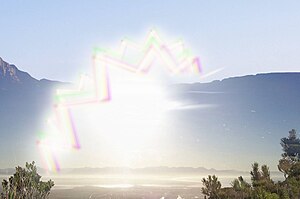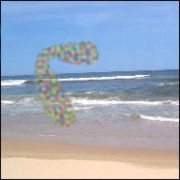아우라(증상)
Aura (symptom)| 아우라 | |
|---|---|
 | |
| 편두통 아우라 현상의 일부로 나타나는 지그재그 선에 대한 아티스트의 묘사 | |
| 전문 | 신경학, 신경안과 |
| 종류들 | 섬광성 스코트마 |
| 차동 진단 | 경색, 망막 편두통, 눈에 보이는 눈이 없는 지속적 아우라 |
아우라는 간질이나 편두통이 있는 사람에 의해 경험되는 지각 장애이다. 뇌전증간질성 아우라는 [1]발작이다.
간질과 편두통 오라는 뇌의 특정 부위가 관여하기 때문에 발생하는데, 오라의 증상을 결정하는 부위이다.따라서 시각영역이 영향을 받으면 아우라는 시각적인 증상으로 구성되고 감각적인 증상으로 구성되면 감각적인 증상이 나타난다.
간질성 오라는 국소 발작에 의한 주관적인 감각 또는 심령 현상이다. 즉, 뇌에서 발작의 원인이 되는 부분이 발작이며, 발작은 아우라의 증상으로 자신을 표현한다.발작의 원인이 되는 변형이 어디에 있는지 명확하게 하기 때문에 중요합니다.간질 방출이 뇌의 다른 부분으로 퍼지기 때문에 대부분의 경우 간질 징후는 발작의 다른 증상, 예를 들어 경련이 뒤따른다.고립된 채로 있는 경우는 거의 없습니다.오라가 발생할 때, 그들 자신 및/또는 다른 사람들이 의식을 잃었을 때 부상을 예방할 뇌전증 시간을 가진 사람들이 허용한다.
편두통
편두통의 조짐은 대부분의 경우 시각적인데, 왜냐하면 기능 장애는 시각적인 피질에서 시작되기 때문이다.그 아우라는 보통 몇 분에서 한 시간까지 다양한 시간이 지나면 편두통이 뒤따른다.그러나 편두통 전조증상은 두통을 동반하지 않고 고립되어 나타날 수 있다.아우라는 편두통이 지속되는 동안 지속될 수 있다; 아우라의 종류에 따라, 사람을 혼란스럽게 만들 수 있다.편두통이 있는 사람들은 편두통 동안 한 가지 이상의 아우라를 경험하는 것이 일반적이다.오라를 가진 대부분의 사람들은 매번 같은 종류의 아우라를 가지고 있다.
오라는 또한 갑작스런 공황 발작, 공황 발작 또는 불안 발작과 혼동될 수 있으며, 이는 진단에 어려움을 일으킨다.통증, 실감, 어지럼증, 흉통, 떨림, 두근거림 등의 증상이 있는 환자에 대한 감별 진단은 상당히 [2]어려울 수 있습니다.
발작
간질성 아우라는 비정상적인 신경 [3]방출에 의한 기능 피질의 활성화의 결과이다.임박한 발작에 대한 경고 신호일 뿐만 아니라, 아우라의 특성은 발작이나 [4][5]편두통의 국부적 및 측면적 위치에 대한 통찰력을 줄 수 있습니다.
가장 흔한 오라는 운동,[6] 체감각, 시각, 청각 증상을 포함한다.아우라 동안 뇌의 활성화는 연속적으로 또는 불연속적으로 같은 쪽 또는 [7]양쪽으로 확산될 수 있습니다.
오라는 특히 국소 발작에서 흔하다.운동피질이 뉴런의 과잉자극에 관여하면 운동오라가 발생할 수 있다.마찬가지로, 체질 감각 피질이 관여하면 체질 감각 오라가 발생할 수 있습니다.1차 체감각 피질이 활성화되면 신체 반대편과 2차 체감각 영역에 더 많은 분리된 부분이 발작의 [8][9]초점에 반하는 증상을 일으킨다.
시각적 오라는 단순할 수도 있고 복잡할 수도 있다.단순한 시각적 증상에는 주로 일차 시각 피질의 비정상적인 활동으로 인해 발생하는 정전기, 점멸 또는 움직이는 조명/모양/색상이 포함될 수 있습니다.복잡한 시각적 오라는 사람, 장면, 그리고 시간-후두 접합부의 자극에 의해 발생하며 한쪽 반쪽 장에 측면으로 치우쳐 있는 물체를 포함할 수 있습니다.청각 오라는 또한 단순하거나(울림, 윙윙거림), 또는 복잡할 수 있습니다(음성, 음악).단순 증상은 일차 청각 피질의 활성화와 청각 관련 [10]영역의 일시 후두피질의 복합 증상으로부터 발생할 수 있다.
예
아우라 감각에는 다음 중 하나 또는 그 조합이 포함됩니다.
시각적 변화
- 밝은 빛과 흐림[11]
- 지그재그[12] 선
- 물체의 크기[13] 또는 형상의 왜곡
- 진동 시야[14]
- 섬광성 스코트마[15][16]
- 흔들림, 맥동 패치, 종종 구부러짐
- 터널 비전
- 스코토마[17]
- 사각지대 또는 다크스팟
- 한쪽 눈 위에 커튼 같은 효과
- 서서히 퍼지는 점
- 만화경[18] 효과
- 한쪽 또는 양쪽[19] 눈의 일시적인 실명
- 빛에 대한 감도 향상[20]
청각의 변화
- 존재하지 않는 소리 또는 소리: 환청[21]
- 환경에서의 음성 또는 소리 변경: 윙윙거리는 소리, 트레몰로, 진폭 변조 또는 기타 변조[22]
- 청각[23] 민감도 향상
- 현기증을[24] 일으키는 전정 기능 장애
기타 감각
- 이상한 냄새(환각)[25] 또는 맛(미각)
- 냄새에 대한 높은 민감도[26]
- 공감각[27]
- 데자뷰 또는 자메이뷰[28]
- 머리 또는 머리[29] 안쪽의 움직임을 감지하는 두부 아우라
- 복부 아우라[30](상복부 상승감 등
- 메스꺼움[31]
- 갑작스런 불안감, 두려움 또는 예감[32]
- 저림 또는 따끔거림(마취)[33]
- 몸의 한쪽이 약함(반신)[34]
- 몸에서 떨어져 있거나 위에 떠 있는 느낌([35]분리)
- 손발이나 치아가[36] 자라는 느낌
- 과열감, 갑작스러운[37] 땀감
- 말을 할 수 없거나(증식) 말을 흐리게[38] 한다.
「 」를 참조해 주세요.
- 국소 발작 – 뇌기능의 고립된 장애에 선행하는 발작을 특징으로 하는 간질 증후군 뇌전증
- 환각 – 실제 지각의 특성을 가진 외부 자극이 없는 경우의 지각
- 경색 없는 지속적 아우라
- 공감각 – 감각 교차를 수반하는 신경학적 상태
- 캐다실
- 망막 편두통
- Photopsia – 시야에서 감지된 섬광의 존재
레퍼런스
- ^ 오라 뇌전증
- ^ Hurley, Robin A.; Fisher, Ronald; Taber, Katherine H. (1 October 2006). "Sudden Onset Panic: Epileptic Aura or Panic Disorder?". The Journal of Neuropsychiatry and Clinical Neurosciences. 18 (4): 436–443. doi:10.1176/jnp.2006.18.4.436. PMID 17135371.
- ^ Perven G and So NK (2015). "Epileptic auras: phenomenologu and neurophysiology". Epileptic Disorders. 17 (4): 549–562.
- ^ Ye, Byoung Seok; Cho, Yang-Je; Jang, Sang Hyun; Lee, Moon Kyu; Lee, Byung In; Heo, Kyoung (2012-05-01). "The Localizing and Lateralizing Value of Auras in Lesional Partial Epilepsy Patients". Yonsei Medical Journal. 53 (3): 477–485. doi:10.3349/ymj.2012.53.3.477. PMC 3343447. PMID 22476989.
- ^ Foldvary-Schaefer, N.; Unnwongse, K. (February 2011). "Localizing and lateralizing features of auras and seizures". Epilepsy & Behavior. 20 (2): 160–166. doi:10.1016/j.yebeh.2010.08.034. PMID 20926350. S2CID 1220765.
- ^ Sharma S., Dixit V. (2013). "Epilepsy – A Comprehensive Review". International Journal of Pharmacological Research & Review. 2 (12): 61–80.
- ^ Tuxhorn I. E. B. (2005). "Somatosensory auras in focal epilepsy: A clinical, video EEG and MRI study". Seizure: European Journal of Epilepsy. 14 (4): 262–268. doi:10.1016/j.seizure.2005.02.005. PMID 15911361. S2CID 18386228.
- ^ Tuxhorn, I. E. B. (2005-06-01). "Somatosensory auras in focal epilepsy: A clinical, video EEG and MRI study". Seizure. 14 (4): 262–268. doi:10.1016/j.seizure.2005.02.005. PMID 15911361. S2CID 18386228.
- ^ Fakhoury, T.; Abou-Khalil, B. (November 1995). "Association of ipsilateral head turning and dystonia in temporal lobe seizures". Epilepsia. 36 (11): 1065–1070. doi:10.1111/j.1528-1157.1995.tb00463.x. PMID 7588449. S2CID 35063423.
- ^ Foldvary-Schaefer, Nancy; Unnwongse, Kanjana (1 February 2011). "Localizing and lateralizing features of auras and seizures". Epilepsy & Behavior. 20 (2): 160–166. doi:10.1016/j.yebeh.2010.08.034. PMID 20926350. S2CID 1220765.
- ^ "Aura: Migraine's Odd Companion". Migraineur. Retrieved 2021-03-17.
- ^ "Patient's Guide to Visual Migraine - Brigham and Women's Hospital". www.brighamandwomens.org. Retrieved 2021-03-17.
- ^ "Alice in Wonderland Syndrome - an overview ScienceDirect Topics". www.sciencedirect.com. Retrieved 2022-01-11.
- ^ Jacome, Daniel E. (2013-02-01). "Migrainous Binocular Peripheral Oscillopsia: A Typical Persistent Visual Aura Without Infarction".
{{cite journal}}:Cite저널을 요구한다journal=(도움말) - ^ "Understanding the Aura Stage of Migraine Doctor Q&A". Migraine Again. 2020-12-30. Retrieved 2021-03-17.
- ^ "Scintillating Scotoma: Causes, Treatment, Risk Factors". Healthline. 2020-11-12. Retrieved 2022-01-11.
- ^ OD, By George T. Banyas. "Visual Aura and Scotomas: What Do They Indicate?". www.reviewofoptometry.com. Retrieved 2022-01-11.
- ^ "What Causes Kaleidoscope Vision?". Greatist. 2020-01-29. Retrieved 2021-03-17.
- ^ Liao, Sharon. "Causes of Temporary Blindness and Short-Term Vision Loss". WebMD. Retrieved 2022-01-11.
- ^ "Photophobia: Causes, symptoms, and treatment". www.medicalnewstoday.com. 2021-08-16. Retrieved 2022-01-11.
- ^ DiLonardo, Mary Jo. "Epilepsy: What is Seizure With Aura?". WebMD. Retrieved 2022-01-11.
- ^ "Migraine and Hallucinations: Visual, Olfactory, and Auditory". Healthline. 2021-04-19. Retrieved 2022-01-11.
- ^ van der Feltz-Cornelis, Christina M; Biemans, Henk; Timmer, Jan (2012). "Hearing voices: does it give your patient a headache? A case of auditory hallucinations as acoustic aura in migraine". Neuropsychiatric Disease and Treatment. 8: 105–111. doi:10.2147/NDT.S29300. PMC 3333787. PMID 22536065.
- ^ Bernetti, L.; Pellegrino, C.; Corbelli, I.; Caproni, S.; Eusebi, P.; Faralli, M.; Ricci, G.; Calabresi, P.; Sarchielli, P. (16 April 2018). "Subclinical vestibular dysfunction in migraineurs without vertigo". Acta Neurologica Scandinavica. 138 (4): 270–277. doi:10.1111/ane.12941. PMID 29658983. S2CID 4887561.
- ^ Jion, Y. I.; Grosberg, B. M.; Evans, R. W. (22 August 2016). "Phantosmia and Migraine With and Without Headache". Headache. 56 (9): 1494–1502. doi:10.1111/head.12890. PMID 27545897. S2CID 36091982.
- ^ "Can Being Sensitive to Smells Impact Migraine?". www.excedrin.com. Retrieved 2022-01-11.
- ^ Marcel Neckar; Petr Bob (11 January 2016). "Synesthetic associations and psychosensory symptoms of temporal epilepsy". Neuropsychiatric Disease and Treatment. 12: 109–12. doi:10.2147/NDT.S95464. PMC 4714732. PMID 26811683.
- ^ Adachi, Naoto; Akanuma, Nozomi; Ito, Masumi; Adachi, Takuya; Takekawa, Yoshikazu; Adachi, Yasushi; Matsuura, Masato; Kanemoto, Kousuke; Kato, Masaaki (2010-07-01). "Two forms of deja vu experiences in patients with epilepsy". Epilepsy & Behavior. 18 (3): 218–22. doi:10.1016/j.yebeh.2010.02.016. PMID 20494621. S2CID 27034245.
- ^ Kakisaka, Y.; Jehi, L.; Alkawadri, R.; Wang, Z. I.; Enatsu, R.; Mosher, J. C.; Dubarry, A. S.; Alexopoulos, A. V.; Burgess, R. C. (August 2014). "Cephalic aura after frontal lobe resection". Journal of Clinical Neuroscience. 21 (8): 1450–1452. doi:10.1016/j.jocn.2013.11.024. PMC 4340243. PMID 24613491.
- ^ Hoffman, Matthew; MD. "Abdominal Epilepsy in Children and Adults". WebMD. Retrieved 2022-01-11.
- ^ Sekimoto, M.; Kato, M.; Kaneko, Y.; Onuma, T. (December 2007). "Ictal nausea with vomiting as the major symptom of simple partial seizures". Epilepsy & Behavior. 11 (4): 582–587. doi:10.1016/j.yebeh.2007.08.023. PMID 18054131. S2CID 45291893.
- ^ "Can a Feeling of Impending Doom Be a Symptom?". Healthline. 2019-09-24. Retrieved 2022-01-11.
- ^ Erickson, J. C.; Clapp, L. E.; Ford, G.; Jabbari, B. (2006). "Somatosensory auras in refractory temporal lobe epilepsy". Epilepsia. 47 (1): 202–206. doi:10.1111/j.1528-1167.2006.00388.x. PMID 16417550. S2CID 25666352.
- ^ Kumar, Anil; Samanta, Debopam; Emmady, Prabhu D.; Arora, Rohan (2021), "Hemiplegic Migraine", StatPearls, Treasure Island (FL): StatPearls Publishing, PMID 30020674, retrieved 2022-01-11
- ^ "Dissociation and depersonalization: Causes, risk factors, and symptoms". www.medicalnewstoday.com. 2019-05-17. Retrieved 2022-01-11.
- ^ "Alice in Wonderland Syndrome: Symptoms, Treatment, and More". Healthline. 2018-02-14. Retrieved 2022-01-11.
- ^ "Brain & Spine Foundation Migraine". Retrieved 2022-01-11.
- ^ "Recognizing Aphasia During a Migraine Attack". www.northsuffolkneurology.com. Retrieved 2022-01-11.
- ^ 페이지 258 인치:




![A "firefly" aura. This variant has been described in cases of persistent aura without cerebral infarction.[39]](http://upload.wikimedia.org/wikipedia/commons/thumb/7/74/Firefly_aura.gif/160px-Firefly_aura.gif)


